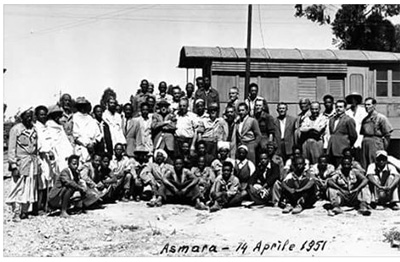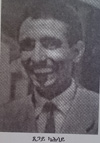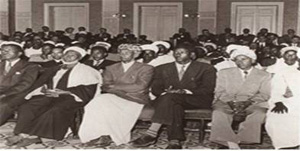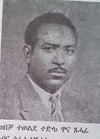
"I am glad and I feel very pround for giving that gift to the people I love dearly". Woldeab's 1982 Rome interview cited by Mesfin.
2.A Brief chrociological history of the Eritrean Workers' Association in the 1950s
Founder of the Trade Unionist

"I am glad and I feel very pround for giving that gift to the people I love dearly". Woldeab's 1982 Rome interview cited by Mesfin.
The intention of this section is to provide a brief history on how a national labour confederation was founded by the Eritrean workers in the 1950s.
The Eritrean workers played a significant part in the struggle for independence and in its achievement in 1991. The history of the Eritrean workers’ civil and political struggle goes back to the flourishing of political parties and the formation work-based unions in the 1940s.During those years the Eritrean workers’ struggle was particularly aimed at getting equal pay and against job based discrimination.
As mentioned earlier during the Italian colonisation the wage structure that discriminated against the Eritrean labour force and the unfavorable working conditions was ideal for the emergence of trade unions; however this didn't happen because political condition under Italian colonialism were unfavourable. As Tom Killion (1997) states that no workers' organizations emerged during the Italian colonial period with the exception of a few pockets of temporary organizations established to protest against specific working conditions. Additionally according Gaim (p99) there were brief strike in the horticultural irrigation scheme at Elabered in 1930 and a strike of Eritrean workers against fascist race laws, led by an Italian who lived with an Eritrean female partner
Although the Italian colonial administration ceased in 1941, the Eritrea workers continue to struggle against the inhuman exploitation and job-based discrimination under the British Military Administration till the mid 1940s. According . (Makki, 2011) certain classes of clerical or other appointments were invariably filled by Italians despite the presence of equally well qualified indigenous employees; whereby indigenous employees doing the same work as Italians were paid less. Additionally Government contracts which could have been carried out by indigenous were given exclusively to Italians. This is also confirmed by Connel (2002: 205) the BMA in Eritrea operated a two tiered wage structure under which Europeans received six times the pay of Eritreans a policy that infuriated Eritrean nationalists
However, in the mid 1940s the British Military Administration(BMA) in Eritrea introduced some liberalization politicise in terms of provision of education, allowing the right to associate and organize, promoted the formation of political parties, trade unions freedom of the press, etc. Consequently the first trade unions were factory based and emerged in 1948; thereafter there were many other work-based unions in the country.
From then on Eritrean workers’ groups organized strikes against, low wages, inequality and discrimination at their work places etc. The first strike had taken place in the port city of Massawa in 1949,, when dock and railroad workers who were suffering from declining port activity and meager wages had gone on strike. Their demands included equal pay and promotion of Eritrean workers. The strike which involved over 1325 workers continued for six weeks from February -March 1949 (Tesfail, 2005 : 114 p. cited by Musie (2011, 112 pages, Connel 2002, 205 p). Mussie adds that the strike had also far-reaching political implications in the BMA recognised. Thereafter the BMA established a formal body known as the native Employment Advisory Committed in 1949, among the main tasks of this Committee included creating non- discriminatory procedures of employment for Eritreans.
Subsequently the British began to compel Italian employers to negotiate with the workers' representatives, and many workers took the opportunity to bargain for higher wages. Such undertakings brought about a general rise in salaries and were later to lead to the formation and recognition of a national confederation of trade union (Mesfin 192)
During the last years of the BMA there were ten labour unions in Asmara representing workers in different industries, including the railroad workers, the SAVA glass factory, Melotti Brewery and smaller organisations of hotel and restaurant workers, printers, mechanics, shoemakers, ceramicists, and others. (Kibreab, 2008).

Asmara railway workers.
In 1951 the ten labour union members played a significant role to form the General Union of Eritreans Labor Syndicates (GUELS). The idea of GUELS was initiated by a couple of Eritrean workers who found it difficult and offensive to work in a discriminatory work environment (Tesfail 2005 122-129 cited by Mussie).
Based on the firsthand accounts gathered and presented by Tesfai, in 1951, Mr Tsegai Kahsaii, Mr Kefela Beraki and Tesfai Zerakersiton, wanted to apply for the work positions offered by the ARAMCO Company. However considering that all three of these people were Christians the company refused to offer the job. The ARAMCO was recruiting Italian and Muslim Eritrean workers for its growing Saudi operations while it refused to hire Eritrean Christian in Saudi Arabia. Instead, it preferred Eritrean Muslim workers whom various positions were offered in the company's employment positions in Saudi Arabia. The preference of Muslims to Christians was also openly told to these applicants (Tesfai 2005: 115-120 cited by Mussie 2011 p112).
Tsegai Kahsaii (1930-2014)

Obituary of Tsegai Kahsai
These workers appealed to (ARAMCO office in Asmara, the American Council in Eritrea and the Arab Communities in Asmara but to no avail. Concerned by the outright labor discrimination on the bases of religion, these individuals published their grievance on July 7, 1951. Their article in the Hantai Eritrea newspaper’s appeared under the title “Labor situation which the public have to know"( Mesfin, 2017)
In September 1951, representatives of those ten trade unions met with Ato Woldeab Woldemariam to discuss the question of the formation of a national labor confederation, and a follow-up meeting took place on November 28, 1951, at the private residence of Sheikh Abdella Gonafir a wealthy and generous merchant to form an Eritrean Workers’ Association.
Dejazamch Abdella Gonafer

The Gonafer meeting played a pivotal role in the formation of the first national and organized labor union in Eritrea, known as the Eritrean Workers Association. Kefela Beraki, one of the applicants to job at the ARAMCO Company and the workers' representatives at the Gonafer meeting, later commented:
After approaching the British officers concerning our labor problems repeatedly, we were reminded of the fact that we did not represent the workers. However, we were advised of the need to set up an organization first. With that advice we went to Woldeab for help. Woldeab offered us his advice and more. In fact, he put in a good word for us with Abdella Gonafer to provide us with a meeting place at his residence.
In Gonafer meeting, its participants, over 300 people, were not only representatives of various shops, but were also leaders of political groups, businessmen, employers and community leaders. Woldeab said that after eight years, one could notice that in the meeting political differences and frictions were greatly declined (Alemseged cited by Mesfin p 193.)
The organizers of the Gonafer meeting argued that the members of the executive committee of any union should all be taken from the working class. After the participants agreed to set up a workers' association, they elected a 10-man committee that included Tsegay Kahsai, Kefela Beraki and others (Alemseged, 2005 p128 cited by Mefin p.193). They also elected a group of community and political leaders whose function was to advise the Executive Committee on labor issues; among the group were nationalists like Woldeab
The British Administration did not oppose the Gonafer meeting, its report to the Foreign Office read as follows:
"The month has seen the stirrings of a Trade Union movement in the territory. An organization calling itself the Eritrean Workers' Association and claiming to protect the rights of Eritrean labor force was founded on the 28th of November 1951 and is now engaged in preparing its statutes for the approval of the Administration".(Mesfin)
Once Woldeab had realized that the British had no objections to the fledge ling Workers' Association, Woldeab devised a plan to visit employers. Woldeab 's role was not only confined to Mobilization factory workers and speaking to employers, but he also began to contact foreign experts for advice. Woldeab played key role in establishing contacts with a London -based agency-the International Confederation of Free Trade Union (ICFTU), a month after the initial meeting was held at Gonafer's place (mesfin p195)
Mesfin(2011) adds that immediate before the Eritrea-Ethiopian federation in 1952 the BMA also attempted to liberalize labor laws. During that period of years a number of small labour groups such as traders’ association and shop owner association also emerged. This was speeded up for the formation of labor organizations and trade unions throughout the country
3. The the Syndicate of Free Eritrean Workers (SFEW)
On July 10, 1952, the newly elected National Assembly approved the Eritrean Constitution which protected the right of workers to form trade union. The Workers Syndicate of Eritrea was founded with the help of Ato Woldeab Woldemariam. According Gebre-Medhin, (1989:171) the veteran workers and agitator Aldo Mafess, and another member of the Italian Communist Party, Carlo Bregaro played important roles in the formation of the Syndicate.
Names of those elected in the 1st Eritrean Parliamentary Election 1952

The opening of the Eritrean Parliament 1952 courtesy of Jelal Yassin
In late 1952, the Eritrean Workers Association tasked Woldeab with finding a new name for their organization and to draft the statues of the confederation, and Ato Woldeab advised them to change the name of the organization to “HZSKSE=Hara Zekhone Semret Kefletat Serahtenyatat Eritrawiyan, officially translated into English as the "Syndicate of Free Eritrean Workerswhich the British Administration recognized in January 1952.
Ato Woldeab who was the founder of the SFEW also told Killon, in 1983, that he had two goals in helping to establish the Syndicate of Free Eritrean Workers: protection of workers’ rights and protection of Eritrea’s autonomous and democratic instauration created by the United Nations and guaranteed by the Eritrean constitution. (Kibreab, 2007, page 109)
In November 1952 the Syndicate of Free Eritrean Workers (SFEW) held its first Congress attended by 300 representatives from all over Eritrea. SFEW was one of the first such organizations in Africa. (Baldwin, states at that time the rest of African states were still under the yoke of the European colonialism. Furthermore, although the 1955 of Ethiopia constitution guaranteed the right to form workers' associations, it was not until 1962 that the Ethiopian government issued the Labor the Relations Decree, which authorized trade unionists
The SFEW which had 4, 000 paid members and 6, 000 associates, held its first congress on the 16 November 1952 a year after the Gonafer meeting, in the presence of more than 300 representatives from 18 factories. Woldeab Woldemariam was elected the first president of the federation.
In Woldeab's leadership team Siraj Abdu was secretary general, Twelde Tedla, first secretary, Abdella Gonafer, treasurer, Kinfe Elfe, Ibrahim Mahmood and Tsegai Kahsai as advisers. Eritrea's first national trade union confederation was one of the first such organizations in Africa. (Mesfin 202).
Twelde Tedla,Tsegai Kahsai Abdella Gonafer



The Congress mandated Ato Woldeab to draft a constitution (killion 1997 p18. which was ratified in the second meeting, held in December 1952.The SFEW was a manifestation of the high level of civic values and consciousness, if not of the average worker, but of the leaders of the confederation. The aims of the confederation were to promote the unity of all Eritrean workers to obtain, within a system of peaceful negotiation with employers, the improvement of labour conditions to institute training courses to secure legal assistance to promote the fulfilment of Eritrean social and labour legislation to establish an Eritrean Workers' Day [Killion 1997 cited by( Kibreab, 2008, 131 )
On November 23 1952 workers' representatives fully endorsed the program and recommendations of the first congress and decided to inaugurate the official establishment of the SFEW two weeks later. On 7 Dcember 1952, SFEW received official recognition (Mesfin 202). The Confederation of Syndicate of Free Eritrean Workers was also formally recognized member of the ILO and had started to participate in its conferences (Baldwin, 2017) .
In accordance with the provision of the Confederation’s constitution, the 7th of December was declared as the Eritrean Workers Day, the first Eritrean workers’ day was subsequently marked on the 7th of December 1952 where over 20,000 participants attended. This was an ample evidence of the powers and popularity that the Eritrean workers’ association commanded at the time.[shabait Administrator, 2012]
In 1953 the confederation of the Eritrean workers staged a number of strikes in pursuit of better working conditions and benefits such as paid annual leave and pensions. The Unionist Party that was in power turned against the Syndicate and its leaders. The office of the Syndicate was temporarily closed after the attempt on Ato Woldeab life.
In August 1953, Ato Woldeab resigned the presidency, after seven attempts on his life, and Ato Wolde-Ab left the country and became an exile in Egypt. The vice-president, Sheikh Mohamed Siraj Abdu, took over Ato Wolde-Ab's duties, but he too was harassed and stepped down in November 1953 when the Syndicate's office was closed by the government. His duties were taken over by young and radical trade unionists such as Tsegai Kahsai, a shoemaker, who became acting vice-president and Tekie Ilffe, a sailor, who became general -secretary of the Syndicate [ Keberab 2008 : 131].
In 1953-1954 the Imperial government of Ethiopia took other measures to bring under state control large scale economic establishments such as transport, communication and many others that employed high number of workers. This measure to bring workers under the government’s control was the first move designed to curtail the Eritrean labour movement and undermine workers’ rights.
The erosion of Eritrea’s Political autonomy through Ethiopian annexation in the 1950’s catapulted the union movement into the leading force of the Eritrean nationalist movement. Trade union rights were withdrawn in 1957. The Trade union opposed the abrogation of the rights of freedom of association. Workers in the two Ports Assab and Massawa organized a strike and many members were jailed.
After 1954, the SFEW was driven underground from where it continued to lobby the Eritrean Assembly to promulgate a labour code and led a number of strike in spite of the intimidation. A number of strike were staged, led by the militant dock and railway workers, in order to counter the erosion of the gain that the labour union had made in the last years of British rule (Kebreab, 2008,132)
The Syndicate was a political as well as a trade-union organization which played a great role in the Workers' strikes and boycotts to frustrate Ethiopia's ambition in Eritrea (Gebre-Medhin (171). Gebre-Medhin adds that during this period the self-employed tailors also formed an underground organization. The workers (dock and railroad workers) defended democratic rights such as strikes, demonstrations and associations enshrined in the Eritrean constitution. Gebrehiwet (1993, p71) also confirmed that the SFEW main interest was the protection of Eritrea’s autonomy. At that time, the main concern of that was the preservation of the country’s political autonomy.
Sadly, the legal status and freedom of the Eritrean workers was curtained by the intensive harassment and campaign of terrors etc in 1958 which will be discussed in more detail later. However this didn't interrupted their political and civil rights struggle which they had started in the 1940s and 1950s. During the 30 years liberation struggle they also played active role to bring about the achievement of independence in 1991.
ehrea.org © 2004-2017. Contact: rkidane@talk21.com | ||||